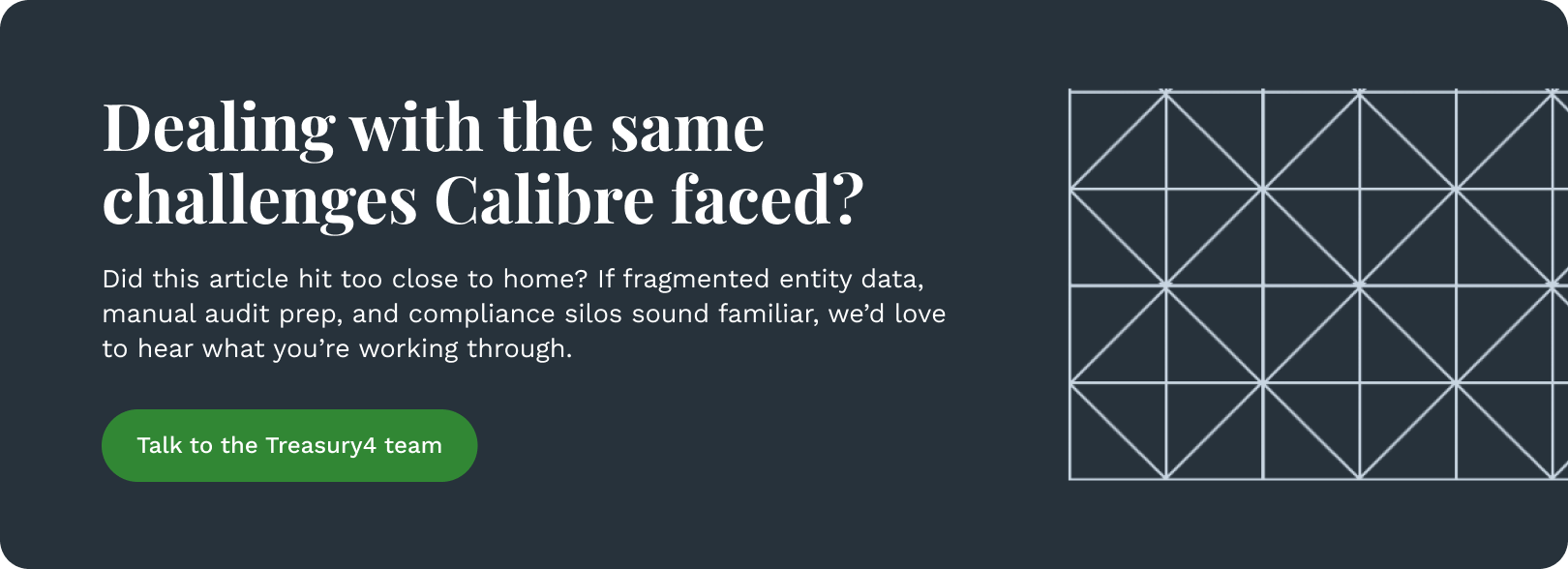The Compliance Headache Treasury Finally Solved
Calibre Scientific’s Julianna Achmatow on building the infrastructure behind audit readiness and cross-functional control
Treasury4 sat down with Julianna Achmatow, CTP, Vice President, Global Treasurer & Legal at Calibre Scientific, to talk about how her team is navigating the growing complexity of global compliance—and why Treasury is uniquely positioned to lead.
Spreadsheets.
If there’s one thing quietly holding back even the most advanced companies from modern compliance, it’s spreadsheets. Legacy habits. And the belief that documentation is something you deal with when the auditors come calling.
Calibre Scientific, a global biosciences company operating in more than 50 countries, had grown quickly through acquisition. With every new entity came new jurisdictions, new bank accounts, and more documentation. The requirements weren’t new, but the expectations were higher.
“I think compliance has always been pretty difficult,” said Julianna Achmatow, CTP, Vice President, Global Treasurer & Legal at Calibre Scientific. “It’s probably just more visible now. But really, it’s the companies that have become more complex. We’re a highly acquisitive, global company, so as we bring in new entities, we have to stay compliant across each new jurisdiction.”
That complexity exposed the limits of Calibre’s infrastructure. Ownership data, signatory authority, and document control lived in disconnected spreadsheets and systems. Treasury was fielding more requests from other teams. Questions took longer to answer. Audit prep was a manual, high-risk process.
Treasury became the system
Calibre implemented Treasury4's Entity4, a legal entity management platform that gives treasury professionals a complete view of their organization and serves as a system of record for managing master data like bank accounts, subaccounts, signatories, and counterparty information.
The rollout took one quarter. Entity4 replaced legacy spreadsheets and gave Treasury, Tax, and Legal a shared, trusted source of truth. It now serves as the system of record for managing bank accounts, signers, entity relationships, and documentation across Calibre’s global footprint—a structure increasingly essential for complex, fast-moving organizations.
Ownership records were no longer duplicated. Document expiration dates were tracked automatically. Signers could be verified without sending emails or calling banks. When internal audit needed supporting documentation, it was all in one place.
“We already provide strategy, visibility on global cash flows, capital structure—we touch on risk,” said Achmatow. “So we’re already a department with a seat at the table. Why not involve Treasury in leading compliance?”
A better fit than ERP or tax tools
Calibre’s ERP and tax platforms still play an important role, but they weren’t designed to manage compliance at the entity level across dozens of jurisdictions.
“ERP and tax platforms are great for day-to-day operations,” Achmatow said. “But they serve specific departments. It’s rare to find an ERP that can do it all.”
Entity4 filled that gap. The platform gave Calibre a structured, secure way to manage sensitive compliance data. Access controls, audit trails, and a clean interface made it easier for stakeholders across departments to find what they needed without creating more work for Treasury.
Legal teams could self-serve. Tax had the right documentation. Audit could verify accuracy without chasing files. Treasury had full visibility across more than 150 bank accounts and every entity in the portfolio.
Foundational for what comes next
Calibre continues to grow. With more M&A integrations and regulatory shifts ahead, the company needed a compliance infrastructure that could scale.
“Access to data is critical,” Achmatow said. “Integration is key, and going at our pace is not always possible. This is really where Treasury4 and Entity4 come in. I’m a big believer in having a system, and I’m very happy using Entity4.”
Entity4 gave Calibre a new level of control—one that simplified day-to-day operations while supporting longer-term strategic planning. Compliance stopped being something to chase. It became something the organization could rely on.
This interview has been edited and condensed for clarity.

Has compliance actually gotten more difficult, or just more visible?
I think compliance has always been pretty difficult. It's probably more visible nowadays, that would be my approach. But frankly, I think it's really the companies that became more complex, right? So maybe that's why compliance is viewed as something that's more difficult nowadays.
We’re a highly, highly acquisitive global company. As we acquire additional companies, we have to make sure we stay compliant in all of the new jurisdictions and countries. Very often, we grow so fast through acquisitions that only after the fact do we realize we need to focus on certain local requirements.
Technology has also changed expectations. The speed at which data moves now means we’re expected to be compliant faster. In some areas, like data protection, the rules have become more demanding. GDPR, for example, keeps evolving and adds complexity around transferring data between entities, countries, and third parties—and how that data is secured and used.
Why is Treasury the right function to lead this transformation?
Treasury is an organization-wide department. We provide strategy, reporting, visibility into global cash flows, capital structure—we touch on risk and so on. We’re already a department that, hopefully, has a seat at the table. So why not involve Treasury in driving compliance too? We’re often seen as the risk management department, and this fits within that scope.
That said, it really comes down to cross-functional collaboration. Treasury, Tax, Legal, and Finance all have to work together. But Treasury can take the lead and bring the rest of the teams into a common solution that benefits the whole company.
Why not solve this through your ERP or tax platforms?
I see ERP and tax platforms more as day-to-day operational tools. They serve specific departments, not really the leadership team. It’s very rare to find an ERP that can do everything. That’s why I would look for a solution outside of those systems to support compliance more holistically.
Is single-tenant architecture really important—and how does data quality factor in?
Access to data is a challenge for many companies. But when it comes to compliance, I think single-tenant architecture is the best option, mainly because of how sensitive that information is.
What would you say to a peer facing similar compliance strain?
I’d highly encourage them to reach out to other teams and collaborate. Treasury can lead, but success comes from cross-functional support.
We already have experience implementing systems to gain visibility into global cash. We understand the IT side. Now we can leverage that experience to support compliance—especially if we have strong collaboration with Tax, Legal, and Finance.
What’s top of mind for you going into 2025 and 2026?
Access to data is critical. At our company, we’ve had a lot of leadership changes. Staying organized while continuing to acquire companies is key. Integration is always a challenge at our pace, and now we see a need to improve.
It comes down to access, ownership, and having the right system. And that’s really where Treasury4 and Entity4 come in. I’m a big believer in having a system—and I’m very happy using Entity4.

